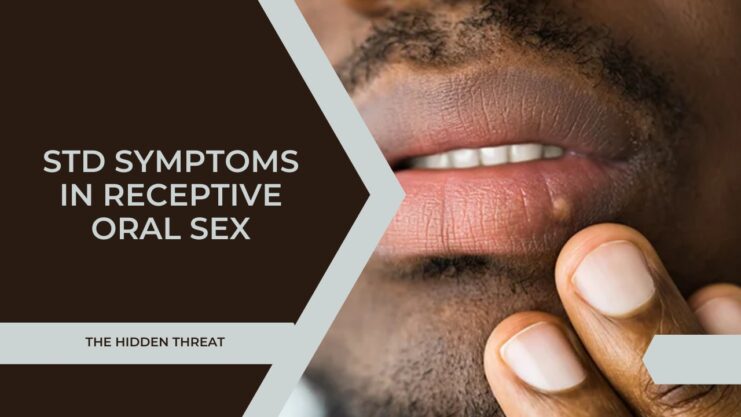Welcome to this comprehensive guide, where we shed light on a topic that is often swept under the rug in many discussions about sexual health: STD symptoms associated with receptive oral sex. While some may believe that oral sex is not a means for the transmission of sexually transmitted diseases (STDs), the reality is different. Oral sex isn’t risk-free. In fact, STDs can be transferred between partners through oral just as they can through vaginal or anal sex.
This article is designed to demystify this crucial subject and provide you with a clear, informative view. We will delve into the specifics of various STDs, their potential symptoms in the context of receptive oral sex, and importantly, how to prevent them. Our aim is to create an open dialogue about sexual health, reducing stigma and misinformation while promoting safe sexual practices.
Understanding the risks associated with all types of sexual activity, including oral sex, is vital to maintaining your health and the health of your partners. In this guide, we will empower you with knowledge, breaking down complex medical jargon into simple, understandable language, and making sure you have all the information you need to protect yourself and your partners. So, let’s begin this important exploration.
First of All Let’s Get Rid of The Big Elephant in The Room: Hiv

Is it possible to get HIV from oral sex?
In a nutshell, it is theoretically possible but highly unlikely. I personally think it is not possible. The only estimated risk ever given for this is 0.04%. This only applies to a person who uses his/her mouth on the partner’s penis and allows him to ejaculate in the mouth (assuming he is HIV +ve). Even then, it is maybe 0.04% possible.
As for The Other STDs, You Can Classify the Possible Symptoms as Follows:
- Throat Symptoms – Sore throat, painful throat, pus on the tonsils, etc
- Skin symptoms – Ulcers, Blisters, etc around the mouth
- General symptoms – Fever, Swollen lymph nodes, etc
1. Throat Symptoms

These symptoms are very much like any other sore throat you have had in the past. It is more suggestive of an STD if the pain is very severe or there is yellow pus on the tonsils. Most people think the tonsil is the teardrop-shaped thing that hangs down in the middle at the back of the mouth. This is the uvula, it is not the tonsils. The tonsils are the 2 spongy round things you see on the sides.
Since sore throats caused by STDs like Gonorrhea or Chlamydia can be no different from your usual sore throat, the only way to know if you have caught an STD in the throat or not is to get a throat swab.
Very painful ulcers in the throat especially if the lymph nodes in the neck are swollen and tender, is very likely to be caused by Herpes.
Although not common, you can also see warts in the mouth caused by HPV. These look like red-colored growths in the mouth most commonly found on the inner lining of the cheek.
Who Are the Culprits?
- Gonorrhea
- Chlamydia
- Herpes
- HPV
When Do Symptoms Usually Appear?
Most commonly within the first 2 weeks of infection but can also take months to appear. Some infections do not even show any symptoms at all.
2. Skin Symptoms

- Ulcers/Blisters. This applies mainly to Herpes. This appears as painful blisters and/or ulcers usually on the line where the lips and the skin meet (vermilion border). However, these ulcers and blisters can also happen anywhere on the face. Ulcers are breaks in the skin. They are usually wet. If the area of skin surrounding it is red, this is more suggestive of Herpes. Blisters are fluid-filled sacs like bubbles on the skin. Herpes ulcers are usually painful.
If you have a single painless ulcer that is slightly bigger (> 8mm), it may be a symptom of Syphilis. This is rare in oral sex but still possible.
- Growths. As discussed above, HPV can cause growth inside the mouth. These same growths can also appear around the mouth and lips although this is rare. This will look like skin-colored lumps which have an uneven surface like a cauliflower.
Who Are the Culprits?
- Herpes
- Syphilis
- HPV
When Do These Symptoms Usually Appear?
Syphilis ulcers can take 9 to 90 days to appear. Herpes ulcers can appear as quickly as within a week or may take months. This also applies to HPV.
3. General Symptoms
- Swollen lymph nodes. Swelling of the lymph nodes is a normal and natural way the body fights off infection. When an area is infected, the lymph nodes close to it will swell to help fight off the infection. So if there is an infection in the throat, the lymph nodes in the neck will swell. This is a very general symptom and can be caused by STDs or non-STD infections.
- Fever. This is an extremely rare symptom for STDs affecting the throat and mouth. If you have a fever, chances are that it has absolutely nothing to do with your oral sex encounter.
Who Are The Culprits?
- Herpes
- Gonorrhea
- Chlamydia
When Do These Symptoms Usually Appear?
Swollen lymph nodes on their own are not a symptom of STDs. However, if you have ulcers in the throat or a bad sore throat AND swollen lymph nodes in the neck, this is more suggestive of STDs.
So the time of onset is related to when the primary symptoms (ulcer, sore throat, etc) appear.
What Do You Do Now?
Not everyone who is infected with an STD will develop symptoms. Of course, if you do have any of the above symptoms, please see us as soon as you can.
If you do not have any of the symptoms, get a full STD screening at 1-month post-exposure to be 100% sure you are clear of everything.
For possible STD throat infections, we can swab the throat to test for Chlamydia, Gonorrhea, HPV, and Herpes.
Understanding the Role of Dental Dams in Preventing STDs
Dental dams are a simple yet effective tool for reducing the risk of STD transmission during oral sex. These thin, square pieces of latex act as a barrier between the mouth and the genitals or anus, preventing direct contact and thus reducing the risk of transmission. They are designed to be used once and then discarded, ensuring that each sexual encounter is as safe as possible. Dental dams are available in a variety of flavors, making them more appealing to use.
Despite their effectiveness, dental dams are often overlooked in discussions about safe sex. This is unfortunate, as they are an easy and affordable way to protect yourself and your partner. Using a dental dam is straightforward: simply unroll the dam, place it over the vagina or anus, and hold it in place during oral sex. Remember to use a new dam for each act of oral sex to prevent cross-contamination.
The Importance of Regular Testing
Regular STD testing is a cornerstone of maintaining sexual health. Many STDs can be asymptomatic, meaning they show no symptoms, making regular testing the only way to detect them. This is particularly important if you’re sexually active with multiple partners or engage in unprotected sex. Regular testing not only helps in early detection and treatment of STDs but also prevents their spread.
It’s recommended to get tested at least once a year, or more frequently if you have new or multiple partners. The process of getting tested is usually quick and straightforward, often involving a simple blood or urine test. Remember, knowing your status is a crucial step in taking control of your sexual health and preventing the spread of STDs to others.
Vaccinations and Their Role in Prevention

Vaccinations play a significant role in preventing certain STDs. For instance, the Human Papillomavirus (HPV) vaccine protects against the types of HPV that most commonly cause health problems like genital warts and cancer. The vaccine is typically given in a series of two or three shots over a period of six months and is recommended for both boys and girls in their preteen years.
Hepatitis A and Hepatitis B vaccines are also available and are recommended for all sexually active individuals. These vaccines can provide long-term protection against these diseases, which can be transmitted through sexual activity. It’s important to consult with a healthcare provider to understand which vaccines are suitable for you and when you should receive them.
The Impact of Oral Health on STD Transmission
Good oral health can potentially reduce the risk of STD transmission during oral sex. Cuts, sores, or gum disease in the mouth can provide an entry point for STDs, increasing the risk of transmission. Therefore, maintaining good oral health is not just important for your overall health, but also for your sexual health.
Regular dental check-ups, brushing twice a day, flossing daily, and using mouthwash can help maintain good oral health. If you have any oral health issues, such as sores or infections, it’s best to avoid oral sex until these have fully healed. Additionally, using protection during oral sex can further reduce the risk of STD transmission.
Communicating with Your Partner
Open and honest communication with your partner about sexual health is key to preventing STDs. Discussing your sexual histories, past STD testing, and the use of protection can help both partners make informed decisions about their sexual health. It’s important to have these conversations before engaging in sexual activity, as this allows both partners to consent to the level of risk they are comfortable with.
Remember, it’s okay to ask your partner to get tested for STDs or to use protection during sex. Your health should always be your priority. It’s also important to discuss what would happen if an unplanned pregnancy occurred or if one of you contracted an STD. These conversations can be difficult, but they are crucial for maintaining a healthy and respectful sexual relationship. It’s always better to be safe and informed than to risk your health due to a lack of communication.
FAQ
What are the common STDs that can be transmitted?
Several sexually transmitted diseases (STDs) can be transmitted through oral sex. These include Chlamydia, Gonorrhea, Syphilis, Herpes, HPV (human papillomavirus), HIV, and Trichomoniasis. The risk of transmission varies depending on the specific STD, the type of sexual activity, and the number of sexual acts performed.
What are the symptoms of STDs from oral sex?
Symptoms of STDs from oral sex can vary depending on the specific disease. Throat symptoms can include a sore throat, painful throat, or pus on the tonsils. Skin symptoms can include ulcers or blisters around the mouth. General symptoms can include fever or swollen lymph nodes. However, many STDs can be asymptomatic, meaning they show no symptoms, making regular testing the only way to detect them.
How can I prevent transmission during oral sex?
Using barrier methods like condoms or dental dams during oral sex can significantly reduce the risk of STD transmission. Regular STD testing, especially if you’re sexually active with multiple partners or engage in unprotected sex, is also crucial. Vaccinations can also play a significant role in preventing certain STDs like HPV and Hepatitis A and B.
What is the role of oral health in transmission?
Good oral health can potentially reduce the risk of STD transmission during oral sex. Cuts, sores, or gum disease in the mouth can provide an entry point for STDs, increasing the risk of transmission. Therefore, maintaining good oral health is not just important for your overall health, but also for your sexual health.
What is the importance of communication in preventing STDs?
Open and honest communication with your partner about sexual health is key to preventing STDs. Discussing your sexual histories, past STD testing, and the use of protection can help both partners make informed decisions about their sexual health. It’s important to have these conversations before engaging in sexual activity, as this allows both partners to consent to the level of risk they are comfortable with.
Final Words
In conclusion, while oral sex is often perceived as a lower-risk sexual activity, it is not without risks. STDs can and do get transmitted through oral sex, and the symptoms can be as varied as the diseases themselves. However, with knowledge and precautionary measures like regular testing, use of barrier methods, maintaining good oral health, and open communication with partners, these risks can be significantly mitigated.
It’s crucial to remember that sexual health is an integral part of overall health, and it’s always better to be safe and informed than to risk your health due to a lack of knowledge or communication.












